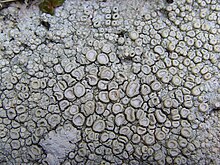I was so excited when I learn about orchil or orcein lichens that produced a pale purple or lavender ink as a pigment in the Book of Kells. How cool is that?
A bit of research indicated what I should be looking for was a local species of Ochrolechia, which when processed with ammonia, would develop a purple dye. However this lichen loves to live on rocks at the coast and being somewhat inland there was no readily accessible supply in any quantity.(NEVER collect lichens unless there is an abundance and they have fallen from their substrate.) Around this time Covid lock-down was in full swing and any visits to the coast were put on hold. I thought there would be plenty of time to revisit this and so looked for alternatives that might work.
Oak moss or stag lichen can also be developed with ammonia to produce, if not purple, then a pinkish lavender wash. Unfortunately, even after three tries, while I was able to get a color shift, I was never able to get it to budge out of muddy maroon into purple. Even trying to shift the pH on the advice of some excellent books, did not help. Dye tests produced a sad medium beige and no matter how concentrated the maroon liquid got, it did not make an interesting or distinct ink color. Which is a pity because we have masses and masses of oak moss that fall to the ground after wind storms if you know where to look.
Experiments with other local lichen were much better: usnea makes a brassy yellow, but only as a dye, not as an ink. And then there's crottle...
Technically crottle is parmelia saxatilis . I used a similar local species Parmelia sulcata. This lichen is reliable. No wonder it was used to dye tweed for centuries. The color starts developing in hours, and really, doesn't need ammonia, but I did it anyway. The dye is dark and produces a nice warm reddish brown. The ink is much weaker, but actually nice for shading. A medium ash beige. So, not traditional, but natural based and useful.
Alas, for the purple that never was. Maybe I can make a trip to the coast over the winter and collect some experimental samples. Failure to make lichen purple ink was the most disappointing aspect of the project.





No comments:
Post a Comment
Note: Only a member of this blog may post a comment.